CITROEN JUMPER 2011 User Guide
Manufacturer: CITROEN, Model Year: 2011, Model line: JUMPER, Model: CITROEN JUMPER 2011Pages: 184, PDF Size: 4.98 MB
Page 11 of 184
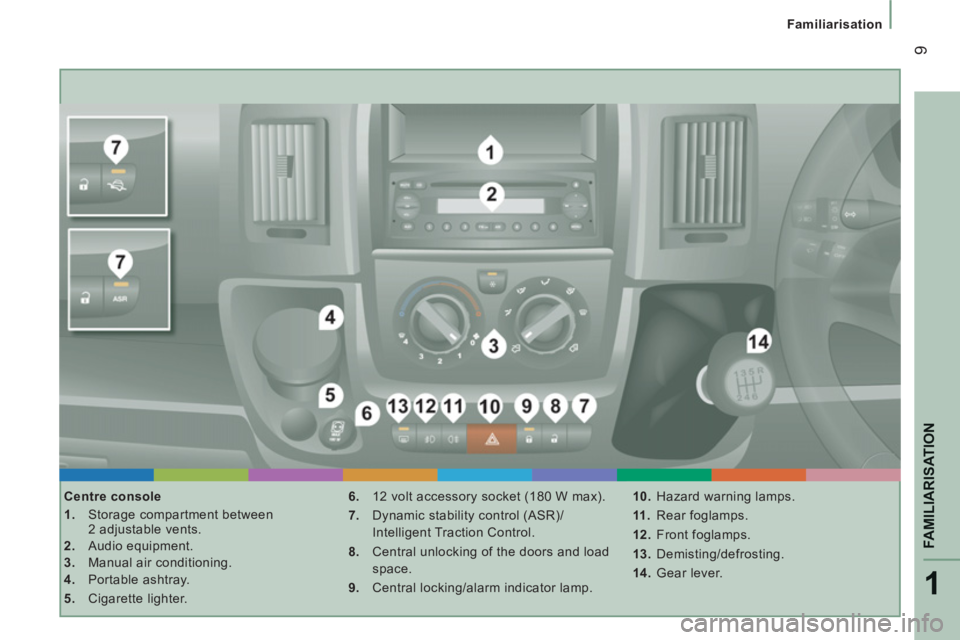
1
FAMILIARISATION
9
Familiarisation
Centre console
1.
Storage compartment between
2 adjustable vents.
2.
Audio equipment.
3.
Manual air conditioning.
4.
Portable ashtray.
5.
Cigarette lighter.
6.
12 volt accessory socket (180 W max).
7.
Dynamic stability control (ASR)/
Intelligent Traction Control.
8.
Central unlocking of the doors and load
space.
9.
Central locking/alarm indicator lamp.
10.
Hazard warning lamps.
11 .
Rear foglamps.
12.
Front foglamps.
13.
Demisting/defrosting.
14.
Gear lever.
Page 12 of 184
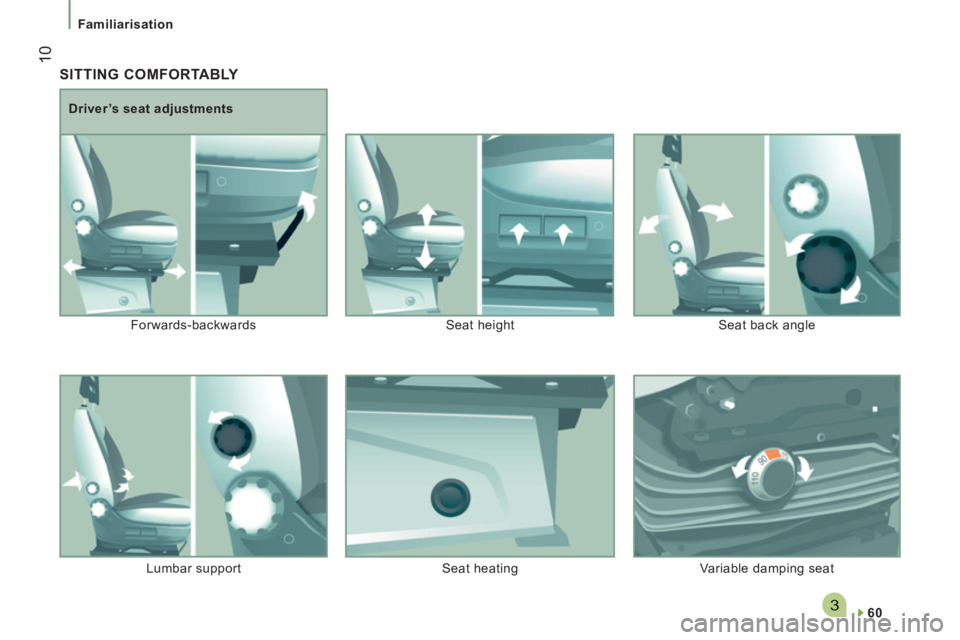
3
10
Familiarisation
SITTING COMFORTABLY
60
Driver’s seat adjustments
Forwards-backwards Seat height Seat back angle
Lumbar support Seat heating Variable damping seat
Page 13 of 184

523
5
1
FAMILIARISATION
11
Familiarisation
SITTING COMFORTABLY
1.
Unlocking the adjustment mechanism.
2.
Locking the adjustment mechanism.
3.
Adjustment of the reach of the steering
wheel.
Manual adjustment of the reach of the
steering wheel
Door mirror adjustment
The mirrors are divided into two zones:
A and B.
1. Driver’s mirror:
A1-
Adjustment of the upper mirror.
B1-
Adjustment of the lower mirror.
2. Passenger’s mirror:
A2-
Adjustment of the upper mirror.
B2-
Adjustment of the lower mirror.
38
72
Front seat belt
Fastening.
Height adjustment.
11 6
11 6
Page 14 of 184
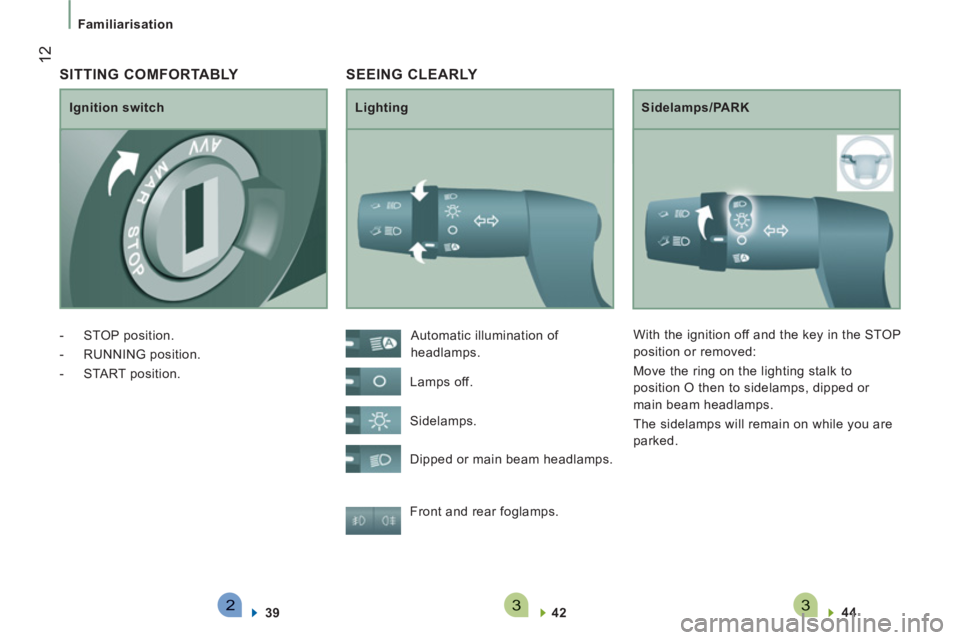
233
12
Familiarisation
SEEING CLEARLY
Lighting
Sidelamps/PARK
Front and rear foglamps.
42
44
Automatic illumination of
headlamps.
Lamps off.
Sidelamps.
Dipped or main beam headlamps. With the ignition off and the key in the STOP
position or removed:
Move the ring on the lighting stalk to
position O then to sidelamps, dipped or
main beam headlamps.
The sidelamps will remain on while you are
parked.
SITTING COMFORTABLY
Ignition switch
- STOP position.
- RUNNING position.
- START position.
39
Page 15 of 184
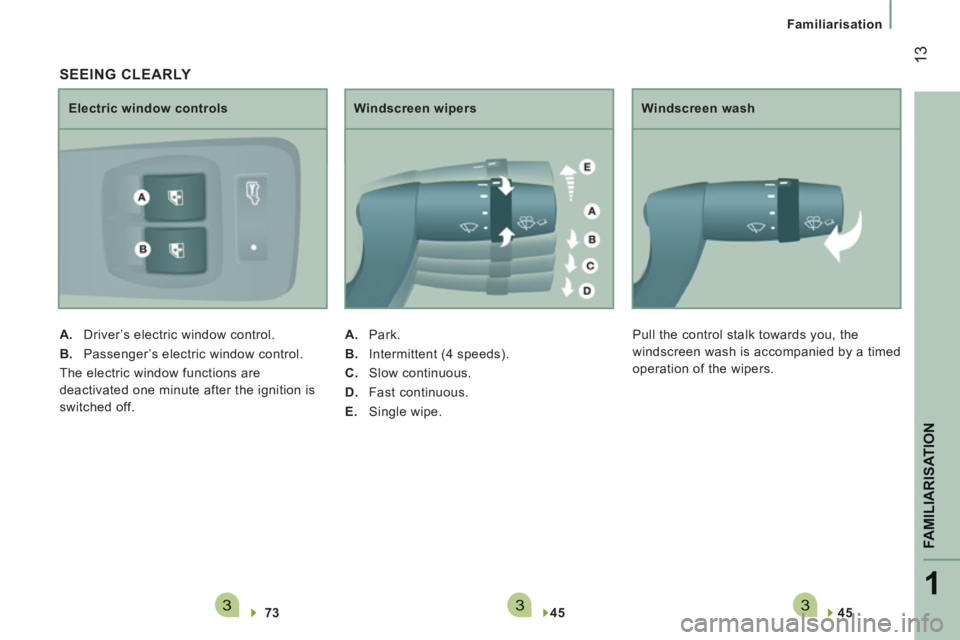
3331
FAMILIARISATION
13
Familiarisation
45
Windscreen wash
Pull the control stalk towards you, the
windscreen wash is accompanied by a timed
operation of the wipers.
SEEING CLEARLY
73
Electric window controls
A.
Driver’s electric window control.
B.
Passenger’s electric window control.
The electric window functions are
deactivated one minute after the ignition is
switched off.
45
Windscreen wipers
A.
Park.
B.
Intermittent (4 speeds).
C.
Slow continuous.
D.
Fast continuous.
E.
Single wipe.
Page 16 of 184
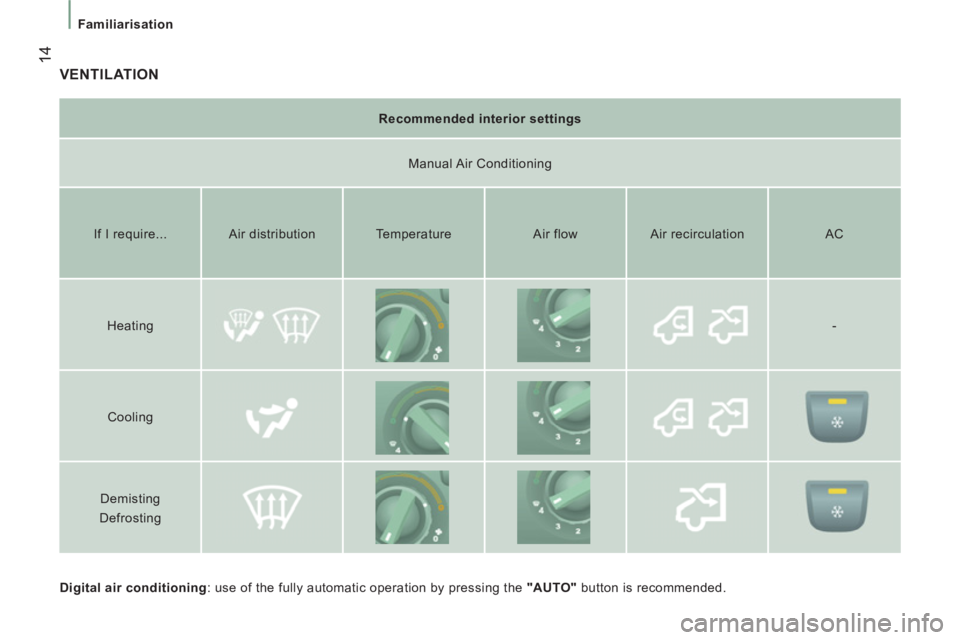
14
Familiarisation
VENTILATION
Digital air conditioning
: use of the fully automatic operation by pressing the "AUTO"
button is recommended.
Recommended interior settings
Manual Air Conditioning
If I require...
Air distribution
Temperature
Air flow
Air recirculation AC
Heating
-
Cooling
Demisting
Defrosting
Page 17 of 184
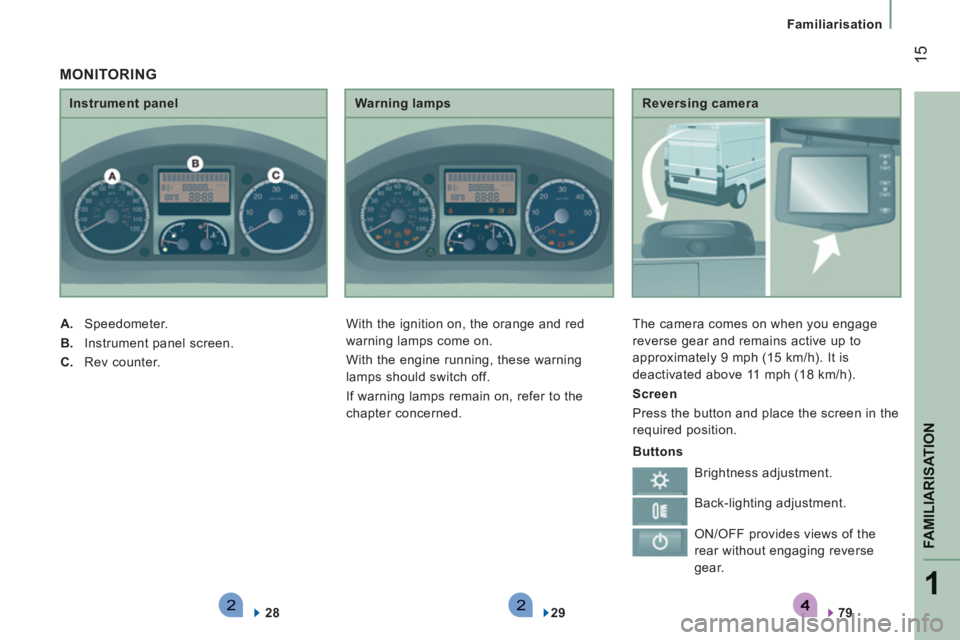
221
FAMILIARISATION
15
Familiarisation
Reversing camera
The camera comes on when you engage
reverse gear and remains active up to
approximately 9 mph (15 km/h). It is
deactivated above 11 mph (18 km/h).
Screen
Press the button and place the screen in the
required position.
79
Instrument panel
A.
Speedometer.
B.
Instrument panel screen.
C.
Rev counter.
28
Warning lamps
With the ignition on, the orange and red
warning lamps come on.
With the engine running, these warning
lamps should switch off.
If warning lamps remain on, refer to the
chapter concerned.
29
MONITORING
Buttons
Brightness adjustment.
Back-lighting adjustment.
ON/OFF provides views of the
rear without engaging reverse
gear.
Page 18 of 184
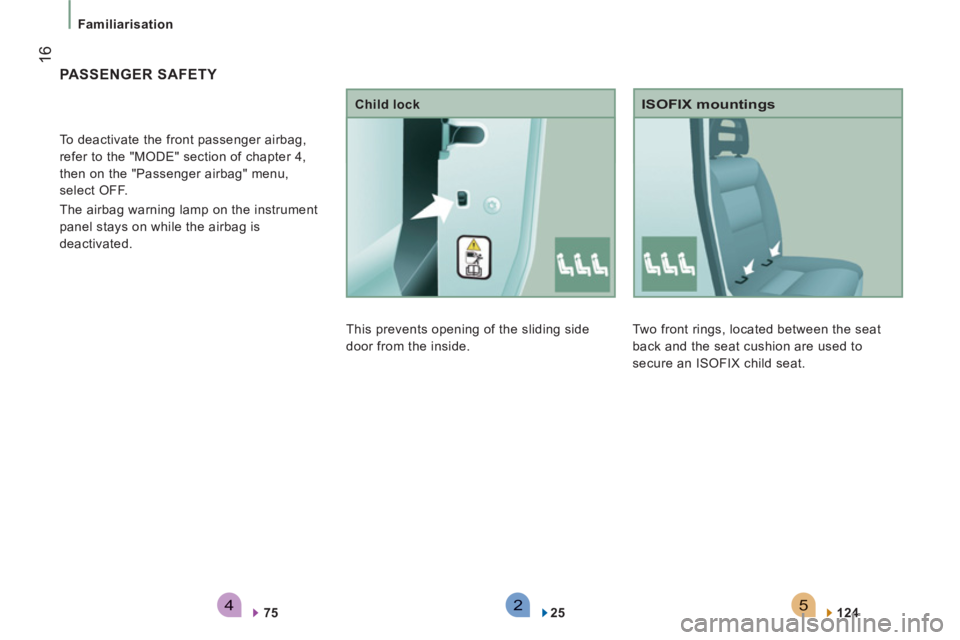
542
16
Familiarisation
Two front rings, located between the seat
back and the seat cushion are used to
secure an ISOFIX child seat.
ISOFIX mountings
124
PASSENGER SAFETY
To deactivate the front passenger airbag,
refer to the "MODE" section of chapter 4,
then on the "Passenger airbag" menu,
select OFF.
The airbag warning lamp on the instrument
panel stays on while the airbag is
deactivated.
75
This prevents opening of the sliding side
door from the inside.
Child lock
25
Page 19 of 184
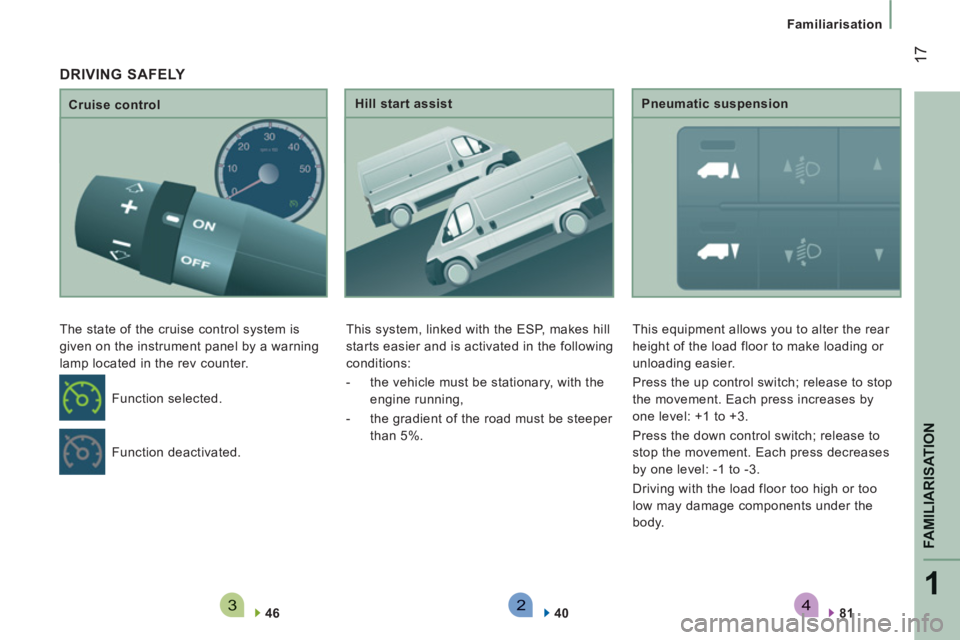
4321
FAMILIARISATION
17
Familiarisation
Cruise control
The state of the cruise control system is
given on the instrument panel by a warning
lamp located in the rev counter.
46
Hill start assist
This system, linked with the ESP, makes hill
starts easier and is activated in the following
conditions:
- the vehicle must be stationary, with the
engine running,
- the gradient of the road must be steeper
than 5%.
40
Pneumatic suspension
This equipment allows you to alter the rear
height of the load floor to make loading or
unloading easier.
Press the up control switch; release to stop
the movement. Each press increases by
one level: +1 to +3.
Press the down control switch; release to
stop the movement. Each press decreases
by one level: -1 to -3.
Driving with the load floor too high or too
low may damage components under the
body.
81
Function deactivated. Function selected.
DRIVING SAFELY
Page 20 of 184
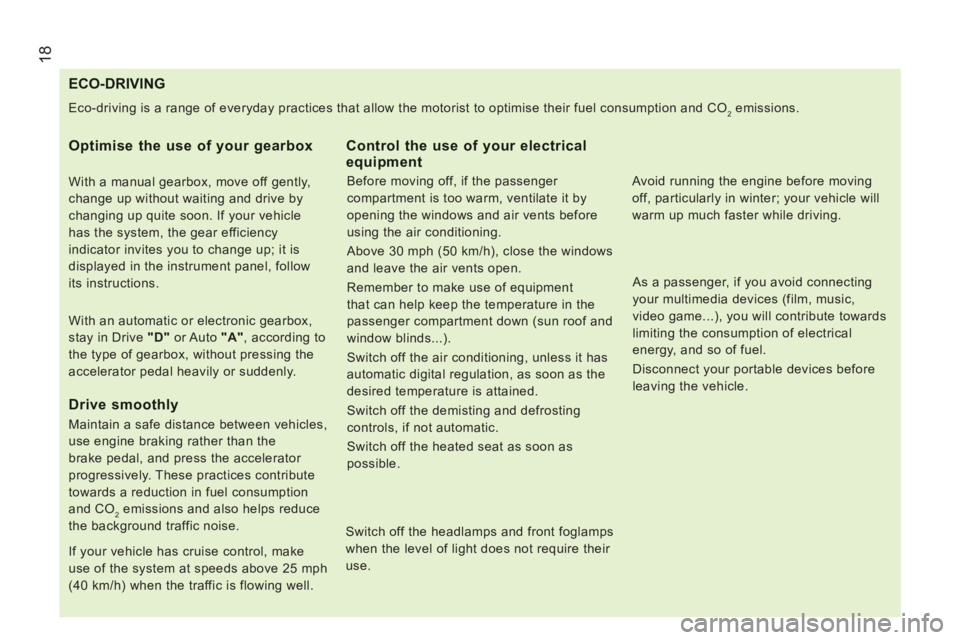
18
ECO-DRIVING
Eco-driving is a range of everyday practices that allow the motorist to optimise their fuel consumption and CO2 emissions.
Optimise the use of your gearbox
With a manual gearbox, move off gently,
change up without waiting and drive by
changing up quite soon. If your vehicle
has the system, the gear efficiency
indicator invites you to change up; it is
displayed in the instrument panel, follow
its instructions.
With an automatic or electronic gearbox,
stay in Drive "D"
or Auto "A"
, according to
the type of gearbox, without pressing the
accelerator pedal heavily or suddenly.
Drive smoothly
Maintain a safe distance between vehicles,
use engine braking rather than the
brake pedal, and press the accelerator
progressively. These practices contribute
towards a reduction in fuel consumption
and CO
2 emissions and also helps reduce
the background traffic noise.
If your vehicle has cruise control, make
use of the system at speeds above 25 mph
(40 km/h) when the traffic is flowing well.
Control the use of your electricalequipment
Before moving off, if the passenger
compartment is too warm, ventilate it by
opening the windows and air vents before
using the air conditioning.
Above 30 mph (50 km/h), close the windows
and leave the air vents open.
Remember to make use of equipment
that can help keep the temperature in the
passenger compartment down (sun roof and
window blinds...).
Switch off the air conditioning, unless it has
automatic digital regulation, as soon as the
desired temperature is attained.
Switch off the demisting and defrosting
controls, if not automatic.
Switch off the heated seat as soon as
possible.
Switch off the headlamps and front foglamps
when the level of light does not require their
use.
Avoid running the engine before moving
off, particularly in winter; your vehicle will
warm up much faster while driving.
As a passenger, if you avoid connecting
your multimedia devices (film, music,
video game...), you will contribute towards
limiting the consumption of electrical
energy, and so of fuel.
Disconnect your portable devices before
leaving the vehicle.